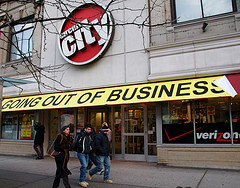The recent announcement that GM has filed for bankruptcy is only the latest in a list of big corporations that have taken the financial plunge- a list that includes such “household names” as Circuit City, KB Toys, CompUSA, Linens n’Things, and most recently, Chrysler). This unavoidable trend also includes many smaller businesses and consumers.
Since this trend is likely to continue for the next year or two ( I’m on the pessimistic side), I wanted to dedicate a post to the subject.
I have found that although most people (especially business owners) may recognize that bankruptcy is something to avoid, they often do not know what actually happens when a business “goes bankrupt.”
The first thing to know is that when it comes to businesses, there are two types of bankruptcy that apply, Chapter 7 and Chapter 11. Each one has very different terms, procedures, and consequences.
Under Chapter 7, also known as “liquidation bankruptcy” once the filing is underway, an administrator or trustee is appointed to sell off the business’ non-exempt assets so that the outstanding debts can be repaid to the fullest extent possible. The portion of the debt that cannot be repaid through the asset liquidation is then discharged. Businesses generally try to avoid Chapter 7, because the process makes it impossible to continue operating.
With a Chapter 11 bankruptcy filing, the business continues its regular operations, maintains control and ownership of all assets, and tries to draw up a plan to pay off creditors. A business will choose to file Chapter 11 if its future revenues will be higher than the liquidation value of its assets. Many of the creditors will also benefit since they can get more money back if they allow the business to reorganize and work out some kind of payment plan. Under the Bankruptcy Abuse Prevention and Consumer Protection Act of 2005, the business has 120 days to come up with its reorganization and payment plan.
The major drawback for filing Chapter 11 is that it can be a costly and time-consuming process. Even smaller businesses will need to hire professionals to help them sort out their debt, and sometimes a plan’s approval can take several months
All business owners who are considering bankruptcy should keep in mind that the bankruptcy will appear on the business’ credit report which will make it harder for the business to get business loans, credit, and leasing contracts for several years. Bankruptcy also stunts business growth. Under Chapter 11, the business can only conduct regular operations. This means no growth-oriented transactions, such as buying a new property or expanding an existing space.
In short, though bankruptcy may help some businesses stay afloat, this “life jacket” has a lot of lead inside of it.

